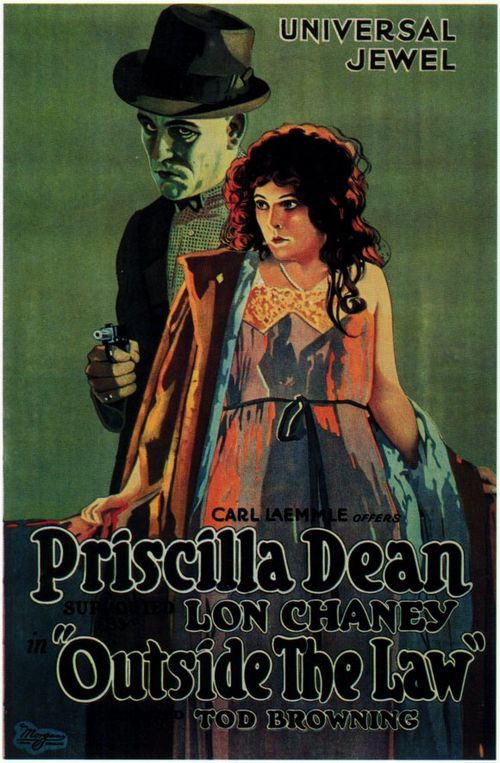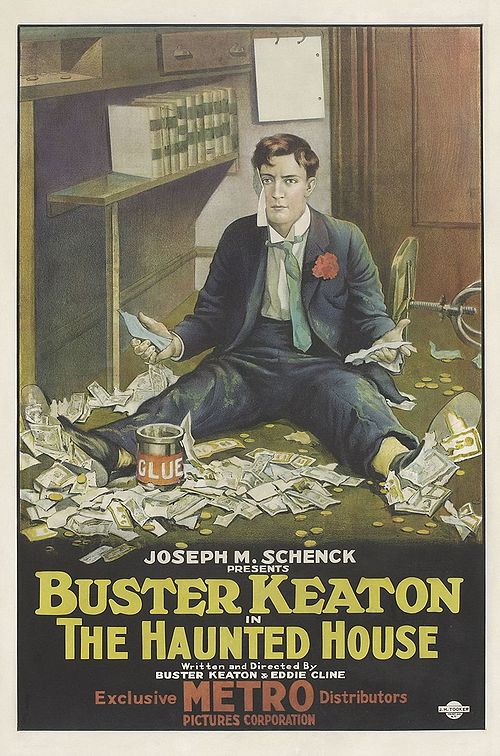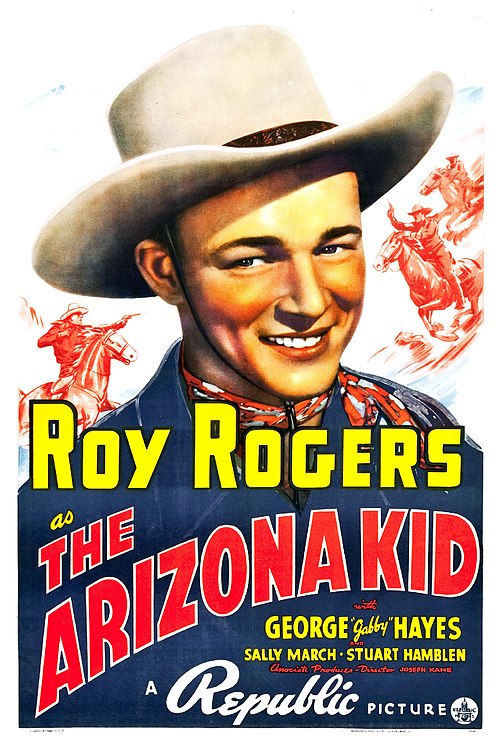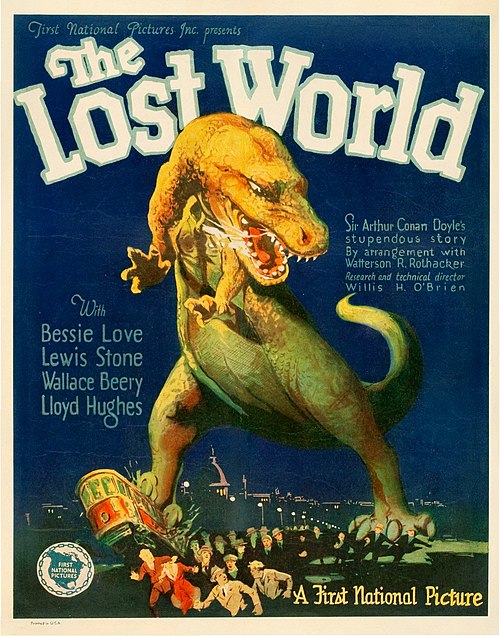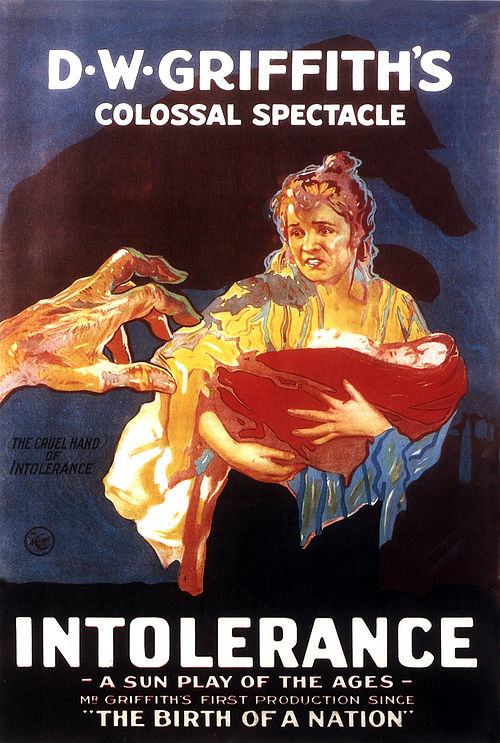Advertisement
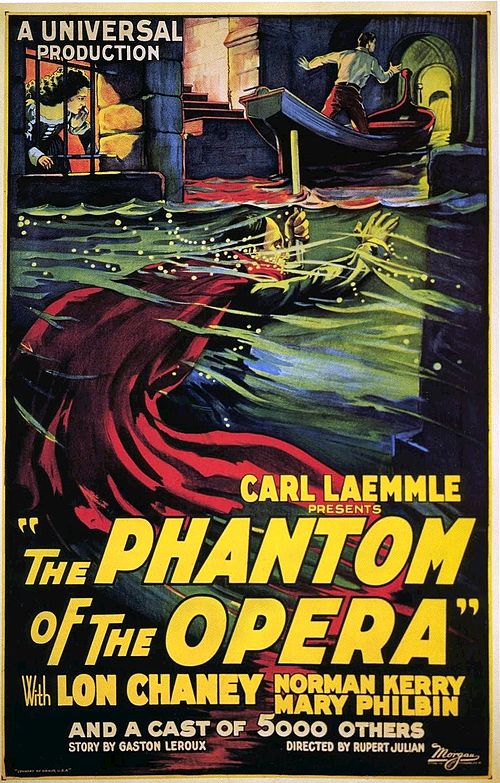
Image source: Wikimedia Foundation (wikimedia.org)
Download Movie [Video Format: MP4]
Movie Source: Internet Archive (archive.org)
Advertisement
Advertisement
Other Versions of this Movie
The Phantom of the Opera
1925
At the Opera of Paris, a mysterious phantom threatens a famous lyric singer, Carlotta and thus forces her to give up her role (Marguerite in Faust) for unknown Christine Daae. Christine meets this phantom (a masked man) in the catacombs, where he lives.
}}
File:The Phantom of the Opera (1925).webm
The Phantom of the Opera is a 1925 American Silent film horror film adaptation of Gaston Leroux's The Phantom of the Opera. It was directed by Rupert Julian and starred Lon Chaney, Sr in the title role of the deformed Phantom who haunts the Palais Garnier, causing murder and mayhem in an attempt to make the woman he loves a star. The movie remains most famous for Chaney's ghastly, self-devised make-up, which was kept a studio secret until the film's premiere.
The picture also features Mary Philbin, Norman Kerry, Arthur Edmund Carewe, Gibson Gowland, John St. Polis, and Snitz Edwards. The last surviving cast member was Carla Laemmle (1909–2014), niece of producer Carl Laemmle, who played a small role as "prima ballerina" in the film when she was about 15.
The Film adaptation by Elliott J. Clawson, Tom Reed (screenwriter) and Raymond L. Schrock and was directed by Rupert Julian and with supplemental direction by Lon Chaney and Edward Sedgwick.
Plot summary
- The scenario presented is based on the general release version of 1925, which has additional scenes and sequences in different order than the existing reissue print (see below).
At the height of the most prosperous season in the Opera's history, the management suddenly resign. As they leave, they tell the new managers of the Opera Ghost, a phantom who asks for opera box #5, among other things. The new managers laugh it off as a joke, but the old management leaves troubled.
After the performance, the ballet girls are disturbed by the sight of a mysterious man in a fez (Arthur Edmund Carewe), who dwells in the cellars. Arguing whether or not he is the Phantom, they decide to ask Joseph Buquet, a stagehand who has actually seen the ghost's face. Buquet describes a ghastly sight of a living skeleton to the girls, who are then startled by a shadow cast on the wall. The antics of stagehand Florine Papillon (Snitz Edwards) do not amuse Joseph's brother, Simon (Gibson Gowland), who chases him off. Meanwhile, Mme. Carlotta (Virginia Pearson), the prima donna of the Paris Grand Opera, barges into the managers office enraged. She has received a letter from "The Phantom," demanding that Christine sing the role of Marguerite the following night, threatening dire consequences if his demands are not met. Christine is in her dressing room at that moment, speaking to a phantom voice (which the audience sees as a shadow on a wall behind the dressing room.) The voice warns her that she will take Carlotta's place on Wednesday and that she is to think only of her career and her master.
The following day, in a garden near the Opera House, Raoul meets Christine and asks her to reconsider his offer. Christine admits that she has been tutored by a divine voice, the "Spirit of Music," and that it is now impossible to stop her career. Raoul tells her that he thinks someone is playing a joke on her, and she storms off in anger.
Wednesday evening, Carlotta is ill and Christine takes her place in the opera. During the performance, the managers go to Box 5 to see exactly who has taken it. The keeper of the box does not know who it is, as she has never seen his face. The two managers enter the box and are startled to see a shadowy figure seated. They run out of the box and compose themselves, but when they enter the box again, the person is gone. In her next performance, Christine reaches her triumph during the finale and receives a standing ovation from the audience. When Raoul visits her in her dressing room, she pretends not to recognize him, because unbeknownst to those in the room, the phantom voice is present. Raoul spends the evening outside her door, and after the others have left, just as he is about to enter, he hears the voice within the room. He overhears the voice make his intentions to Christine: "Soon, Christine, this spirit will take form and will demand your love!" When Christine leaves her room alone, Raoul breaks in to find it empty. Carlotta receives another discordant note from the Phantom. Once again, it demands that she take ill and let Christine have her part. The managers also get a note, reiterating that if Christine does not sing, they will present "Faust" in a house with a curse on it.
Image:PhantomOp.jpg) and Christine Daaé (Mary Philbin)}}}
The following evening, despite the Phantom's warnings, a defiant Carlotta appears as Marguerite. At first, the performance goes well, but soon the Phantom's curse takes its effect, causing the great, crystal chandelier to fall down onto the audience. Christine runs to her dressing room and is entranced by a mysterious voice through a secret door behind the mirror, descending, in a dream-like sequence, semi-conscious on horseback by a winding staircase into the lower depths of the Opera. She is then taken by gondola over a subterranean lake by the masked Phantom into his lair. The Phantom introduces himself as Erik (The Phantom of the Opera) and declares his love; Christine faints, so Erik carries her to a suite fabricated for her comfort. The next day, when she awakens, she finds a note from Erik telling her that she is free to come and go as she pleases, but that she must never look behind his mask. In the next room, the Phantom is playing his composition, "Don Juan Triumphant." Christine's curiosity gets the better of her, and she sneaks up behind the Phantom and tears off his mask, revealing his hideously deformed face. Enraged, the Phantom makes his plans to hold her prisoner known. In an attempt to plead to him, he excuses her to visit her world one last time, with the condition that she never sees her lover again.
Released from the underground dungeon, Christine makes a rendezvous at the annual masked-ball, which is graced with the Phantom in the guise of the 'The Masque of the Red Death' from the Edgar Allan Poe short story of the same name. Raoul finds Christine and they flee to the roof of the Opera House, where she tells him everything that followed the chandelier crash. However, an unseen jealous Phantom perching on the statue of Apollo overhears them. Raoul plans to whisk Christine safely away to London following the next performance. As they leave the roof, the mysterious man with the fez approaches them. Aware that the Phantom is waiting downstairs, he leads Chrstine and Raoul to another exit.
The following evening, Raoul meets Christine in her dressing room. She has heard the voice of the Phantom, who has revealed that he knows their plans. Raoul has arranged for a carriage and reassures her nothing will go wrong.
Backstage, Simon finds the body of his brother hanging by the strangler's noose and vows vengeance. During the performance, the Phantom kidnaps Christine off the stage during a blackout. Raoul rushes to Christine's dressing room, and meets the man in the fez, who reveals himself to be Inspector Ledoux, a secret policeman who has been studying Erik's moves as the Phantom since he escaped as a prisoner from Devil's Island. Ledoux reveals the secret door in Christine's room and the two men enter the catacombs of the Opera House in an attempt to rescue Christine. Instead, they fall into the Phantom's dungeon, a torture room of his design. Philippe has also found his way into the catacombs looking for his brother, and a clanging alarm alerts the Phantom to his presence in a canoe on the lake. Phillipe is drowned by Erik, who returns to find the two men in the torture chamber. Turning a switch, the Phantom subjects the two prisoners to intense heat.
The Phantom gives Christine a choice of two levers: one shaped like a scorpion and the other like a grasshopper. One of them will save Raoul's life, but at the cost of Christine marrying Erik, while the other will blow up the Opera. Christine picks the scorpion, but it is a trick by the Phantom to "save" Raoul and Ledoux from being killed by heat — by drowning them. Christine begs the Phantom to save Raoul, promising him anything in return, even becoming his wife. At the last second, the Phantom opens a trapdoor in his floor through which Raoul and Ledoux are saved.
A mob, led by Simon, infiltrates the Phantom's lair. As the clanging alarm sounds and the mob approaches, the Phantom attempts to flee with Christine in the carriage meant for Raoul and Christine. While Raoul saves Christine, the Phantom is pursued and killed by a mob, who throw him into the Seine River to finally drown. In a brief epilogue, Raoul and Christine are shown on their honeymoon in Viroflay.
Cast
- Lon Chaney, Sr. as Erik (The Phantom of the Opera)
- Mary Philbin as Christine Daaé
- Norman Kerry as Viscount Raoul de Chagny
- Arthur Edmund Carewe as The Persian
- Gibson Gowland as Simon Buquet
- John St. Polis as Comte Philippe de Chagny
- Snitz Edwards as Florine Papillon
- Mary Fabian as Carlotta (The Phantom of the Opera) (1930 redux)
- Virginia Pearson as Carlotta/Carlotta's mother (1930 redux)
- Bernard Siegel (actor) as Joseph Buquet
- Edward Martindel as Comte Phillipe de Chagny (1930 redux)
- Joseph Belmont as a stage manager
- Alexander Bevani as Méphistophélès
- Edward Cecil as Faust
- Ruth Clifford as ballerina
- Roy Coulson as the Jester
- George Davis (actor) as The guard outside Christine's door
- Madame Fiorenza as Madame Giry, keeper of the box
- Cesare Gravina as a retiring manager
- Bruce Covington as Monsieur Moncharmin
- William J. Humphrey as Monsieur Debienne
- George B Williams as Monsieur Ricard
- Carla Laemmle as Prima Ballerina
- Grace Marvin as Martha
- John Miljan as Valéntin
- Rolfe Sedan as an undetermined role
- William Tracy as the Ratcatcher, the messenger from the shadows
- Anton Vaverka as Prompter
- Olive Ann Alcorn as La Sorelli
- Chester Conklin as Orderly
- Ward Crane as Count Ruboff
- Vola Vale as Christine's maid
- Edith Yorke as Mama Valerius
Production
In 1922, Carl Laemmle, the president of Universal Pictures, took a vacation to Paris. During his vacation Laemmle met the author Gaston Leroux who was working in the French film industry. During a conversation they had, Laemmle told Leroux that he admired the Paris Opera House. Leroux gave Laemmle a copy of his 1911 novel The Phantom of the Opera. Laemmle read the book in one night and bought the film rights as a vehicle for actor Lon Chaney, Sr..< name=pttpom>Pace to </> Production started in late 1924 at Universal Studios and did not go smoothly. According to the Director of Photography, Charles Van Enger, throughout the production Chaney and the rest of the cast and crew had strained relations with director Rupert Julian. The first cut of the film was previewed in Los Angeles on January 7 and 26, 1925. The score was prepared by Joseph Carl Breil. No information survives as to what the score consisted of other than Universal's release: "Presented with augmented concert orchestra, playing the score composed by J. Carl Briel, composer of music for "Birth of a Nation". The exact quote from the Opening Day full page ad in the Call Bulletin read: "Universal Weekly claimed a 60-piece orchestra. Moving Picture World reported that "The music from 'Faust' supplied the music [for the picture]." Due to poor reviews and reactions, the January release was pulled. On advice from Chaney and others, Universal told Julian to re-shoot most of the picture and change the style, as it was feared that a Gothic melodrama would not recoup the film's massive budget. Julian eventually walked out.Edward Sedgwick (later director of Buster Keaton's 1928 film The Cameraman) was then assigned by producer Carl Laemmle to re-shoot and redirect the bulk of the film. Raymond L. Schrock and original screenwriter Elliot Clawson wrote new scenes at the request of Sedgewick. The film was then changed into more of a romantic comedy with action elements than the dramatic thriller that was originally made. Most of the newly added scenes depicted added subplots, with Chester Conklin and Vola Vale as comedic relief to the heroes and Ward Crane as the Russian, "Count Ruboff" dueling with Raoul for Christine's affection. This version was previewed in San Francisco on April 26, 1925, and did not do well at all, with the audience booing it off of the screen. "The story drags to the point of nauseam", one reviewer stated.
The third and final version was the result of Universal hold-overs Maurice Pivar and Lois Weber, who edited the production down to nine reels. Most of the Sedgwick material was deleted, though notably the ending, with the Phantom being hunted by a mob and then being thrown into the Seine River, remained. Much of the originally deleted Julian was reedited into the picture, though some important scenes and characters were still missing. This version, containing material from both the original 1924 shooting and some from the Sedgwick reworking, was then set to be released. It debuted on September 6, 1925, at the Astor Theatre (New York) in New York City.<></> It premiered on October 17, 1925, in Hollywood, California. The score for the Astor opening was to be composed by Gustav Hinrichs. Hinrichs' score was not prepared in time, so instead, according to Universal Weekly, the premiere featured a score by Eugene Conte, composed mainly of "french airs" and the appropriate Faust cues.</> In 2014 the Paris Opera House set went through a preservation effort and was placed into storage in preparation for the demolition of Soundstage 28. Soundstage 28 was completely demolished on September 23rd 2014. Universal was contractually unable to loop Chaney's dialogue, but "third person" dialogue by the Phantom was looped over shots of his shadow. (The voice-overs are uncredited, but are probably Phillips Smalley.) Because Chaney's talkie debut was eagerly anticipated by film-goers, advertisements emphasized, "Lon Chaney's portrayal is a silent one!"
The sound version of Phantom opened on February 16, 1930, and grossed another million dollars. This re-issue of the film is lost, although the soundtrack discs survive.
{| class="wikitable" align=right style="text-align:center;"
! colspan=2| Lon Chaney, Sr.<br />in The Phantom of the Opera
|- style="font-size:smaller;
|Image:Lon chaney sr.JPG
|Image:ChaneyPhantomoftheOpera.jpg
|}
The success of The Phantom of the Opera inspired Universal to finance the production of a long string of horror films such as Dracula (1931 English-language film) and its sequels, Frankenstein (1931 film) and its sequels, The Wolf Man (1941 film), The Invisible Man (film), The Mummy (1932 film).
=Eastman House print mystery=
No one knows for sure what the negative used to strike the Eastman House print was produced for, due to footage from the 1930 re-issue placed in it and its lack of wear or damage.To add to the confusion, an opening prologue of a man with a lantern has been added, using a single continuous take, but no title cards or dialogue survives. It would seem that this shot was a talking sequence, but it shows up in the original 1925 version, this time truncated and with a different, close-up shot of the man with the lantern. To further confuse the issue of the 1930 re-issue, the opening title sequence, the lantern man, and the footage of Mary Fabian performing as Carlotta and Mary Philbin's opera performances are photographed at 24 frames per second (sound speed), and theore are all new footage. It is possible that the 'lantern man' is meant to be Joseph Buquet, but the brief, remaining close-up footage of the character from the 1925 version does not appear to be Bernard Siegel, who plays Buquet. The man who appears in the re-shot footage could also be a different actor, but since there is no close-up of the man in this version, and the atmospheric lighting partially obscures his face, it is difficult to be certain.
While it was common practice to simultaneously shoot footage for prints designed for both domestic and foreign markets with multiple cameras, the film is one of few to survive with footage of both versions available (others include Buster Keaton Steamboat Bill Jr. and Charlie Chaplin The Gold Rush). Comparisons of both versions (in both black & white and color footage) yield:
- Footage of most of the same scenes shot from slightly different angles
- Different takes for similar scenes
- 24fps sound scenes replacing silent scene footage
- Variations in many re-written dialogue and exposition cards in the same font
- It is an "International Sound Version" for foreign markets.
- It is a silent version for theaters not yet equipped with sound in 1930.
- it is a negative made for Universal Studio's erence.
==International Sound Version==
Image:Titlecards.jpgInternational versions were sound versions of films which the producing company did not feel were worth the expense of re-shooting in a foreign language. They were meant to cash in on the talkie craze; by 1930 anything with sound did well at the box-office while silent films were largely ignored by the public. These "international sound versions" were basically part-talkies and were largely silent except for musical sequences. Since the film included a synchronized music and a sound effect track, it could be advertised as a sound picture and could theore capitalize on the talkie craze in foreign markets (instead of the more expensive method of actually re-filming talking sequences in foreign languages).
To make an international version, the studio would simply insert (on the soundtrack) music over any dialogue in the film and splice in some title cards (which would be replaced with the appropriate language of the country). Singing sequences were left intact as well as any sound sequences that did not involve speaking.
The surviving sound discs of The Phantom of the Opera belong to the domestic release and theore do not synchronize with the dialogue portions of the film which have been abbreviated on the existing print. There is no record to substantiate what the "international version" of The Phantom was, nor is there any erence that it was even available. Furthermore, one negative was made for all of Europe and sent overseas. The negative was generally left there and the version that is now seen shows no signs of negative wear that would be consistent with that of a negative printed for a number of countries.
==Silent version==
During the transition to sound in 1930, it was not uncommon to see a silent and a sound version of a picture playing simultaneously (particularly from Universal, who kept a silent/sound policy longer than most studios). One speculation is that the Eastman House print is actually a silent version of the film made for theaters not yet equipped with sound.However, according to trade journals of the time, only the sound version was available. The possibility is that Universal made a silent version from unused trims (the original negative was heavily worn, as seen by the Show-At-Home prints struck during this period), but decided not to do anything with it. Furthermore, by 1930 fewer exhibitors were booking totally silent films and this had forced all the major studios to add soundtracks and dialogue sequences to all of their major releases which had previously been intended for release as a silent picture. Studios did not spend much time or money in making silent versions, which were meant to be played in rural areas whose theaters could not yet afford the conversion to sound. Nevertheless, if the extant print is a silent version, it would explain why Universal still had it and also the lack of wear on the negative.
=Color preservation=
Image:Phantomtechnicolor.jpgAccording to Harrison's Reports, a trade journal, when the film was originally released, it contained 17 minutes of color footage; that color footage was retained in the 1930 part-talking version.</> and may be freely downloaded from the Internet Archive. It was parodied in the 1970s film Phantom of the Paradise and by the Terry Pratchett novel Maskerade.
This film was #52 on Bravo (US TV channel)'s 100 Scariest Movie Moments The film was one of 400 films nominated to be on the AFI's 100 Years... 100 Movies (10th Anniversary Edition). The avant-garde jazz ensemble Club Foot Orchestra has written a new Film score and performed it live in accompaniment to the film.
Universal would be involved in four more Phantom adaptations. They released Film remake in Phantom of the Opera (1943 film), distributed the Hammer Films remake in The Phantom of the Opera (1962 film), distributed the The Phantom of the Opera (2004 film) of the The Phantom of the Opera (1986 musical) in Latin America and Australia and the The Phantom of the Opera at the Royal Albert Hall of the same musical
See also
- List of early color feature films
- List of films in the public domain
- Phantom of the Opera (1943 film)
Notes
Category:The Phantom of the Opera
Category:1925 films
Category:1920s horror films
Category:American films
Category:American horror films
Category:American silent feature films
Category:Black-and-white films
Category:Films based on works by Gaston Leroux
Category:Films directed by Rupert Julian
Category:Films directed by Edward Sedgwick
Category:Films directed by Lon Chaney, Sr.
Category:Films about entertainers
Category:Films based on horror novels
Category:Films set in Paris
Category:Films set in a theatre
Category:Monster movies
Category:Films about opera
Category:Silent films in color
Category:United States National Film Registry films
Category:Universal Monsters film series
Category:Universal Pictures films
Category:Films based on French novels
Carl Laemmle


